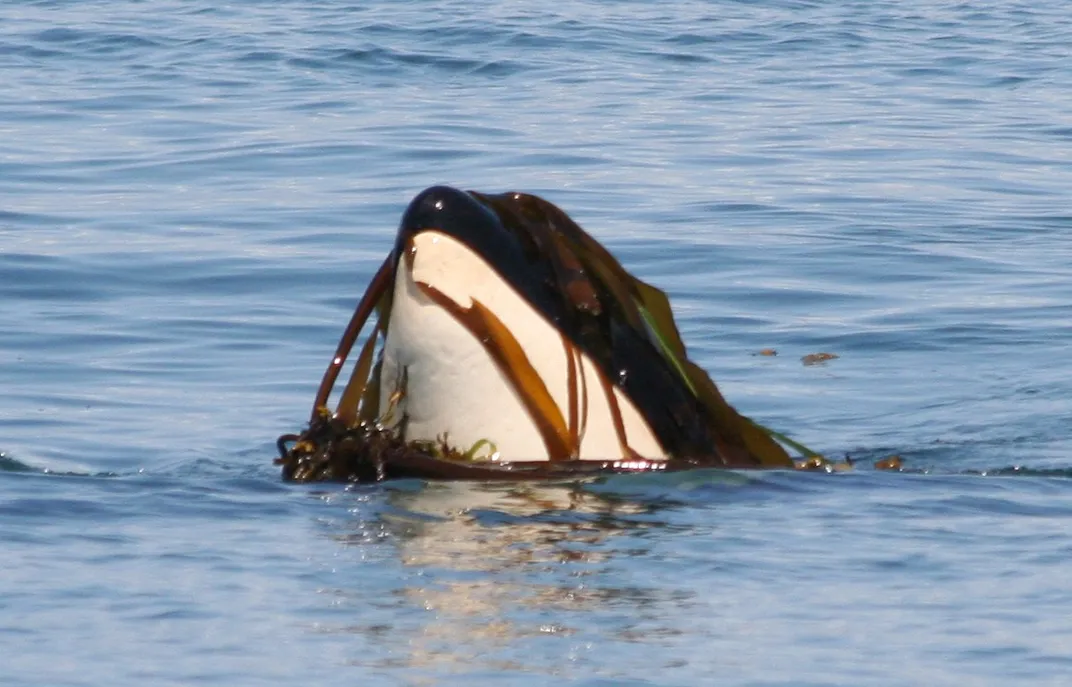However after the orcas took to carrying lifeless salmon on their heads, the habits disappeared. Seemingly, it went out of fashion—simply as shortly because it had caught on. Lately, nonetheless, folks started speculating that the fishy headgear has been adopted as soon as once more by a inhabitants of northeast Pacific orcas often called the Southern Residents.
This fall, whale watchers and scientists in Washington State witnessed no less than two sightings of orcas swimming with a fish on their heads in South Puget Sound and off Level No Level. In late October, the Orca Community, a nonprofit group devoted to educating the general public on killer whales, revealed a photograph of one of many sightings in its e-newsletter. Consequently, the picture “sparked a firestorm of memes and media consideration in regards to the retro pattern returning,” Stephanie Raymond, program supervisor of Orca Community, tells Smithsonian journal in an electronic mail.
However some specialists try to place the brakes on describing this picture because the revival of a bygone trend assertion. “In my view, it’s a stretch to say it was a salmon hat, and a good better stretch to say the fad is again off a single photograph,” Monika Wieland Shields, director of the Orca Conduct Institute, tells CHEK Information.
Raymond echoes that sentiment, suggesting that if the habits actually was widespread, different observers would have noticed it by now.
“When the Southern Resident orcas go to the inland waters of Puget Sound, there is no such thing as a scarcity of eyes on the water and cameras capturing their go to, along with permitted analysis vessels rigorously observing them,” Raymond says. “If the salmon ‘carrying’ habits exhibited by the whale… was, in truth, a revival of the previous pattern, there can be ample documentation of that.”
“In actual fact, there have been no different additional latest photos of those orcas carrying salmon hats,” she provides.
Deborah Giles, science and analysis director for the nonprofit group Wild Orca, additionally not too long ago noticed an orca with a lifeless salmon on its head, however the animal disappeared earlier than anybody might get an image.
However to her, the habits isn’t utterly unfamiliar. In 19 years of subject work with these orcas, Giles tells Smithsonian journal she’s seen the habits “perhaps a handful of instances.” Scientists don’t know why it occurs, she provides, and so they don’t understand how usually it happens.

Usually, orcas do typically interact with what researchers name a “fad”: a pattern began by one or a number of people that will get briefly adopted by others, per Stay Science’s Sascha Pare.
“Killer whales do have fads that come and go, and so they’re usually most prevalent amongst sure intercourse and age lessons within the inhabitants. Then, over time, they have an inclination to vanish,” Jared Towers, director of the conservation group Bay Cetology, informed Uncover journal’s Sean Mowbray in 2022 whereas discussing one other mysterious orca habits: ramming into boats.
The Southern Resident orcas are a critically endangered inhabitants of simply 73 people residing within the northeast Pacific Ocean. They’re “definitely worthy of our fascinated consideration, however there may be a lot extra about them to research and respect” past the salmon hats, Raymond says. For instance, the orcas can usually be noticed “kelping”—dragging seaweed round—typically carrying it on their dorsal fin or snout.
The dead-salmon-hat pattern disappeared, “like so many questionable decisions in gown,” per Futurism’s Frank Landymore, and regardless of what the web says, it most likely hasn’t made a comeback but. If the pattern ever does return, nonetheless, scientists can now—in contrast to within the ’80s—extra simply use know-how reminiscent of drones to watch the orcas, and probably clear up the thriller.
Editor’s be aware, December 6, 2024: This story has been up to date to make clear Deborah Giles’ interpretation of the orca habits.